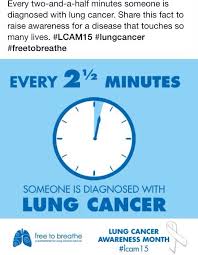For many people, the first sign that they may have lung cancer is the appearance of a suspicious spot on a chest x-ray or a CT scan. But an image alone is not enough to tell you whether you have cancer and, if so, what type of cancer it is.
Most people who come to us for a lung cancer diagnosis first meet with a surgeon. He or she will work with pathologists, radiologists, and other lung cancer specialists to determine the specific type of lung cancer you have and how advanced it is. These findings help your disease management team develop the most successful treatment plan for you.
The first step is for your doctor to get a tissue sample using one of several biopsy methods. Then a pathologist — a type of doctor who specializes in diagnosing disease —who focuses on lung cancer studies the tissue under a microscope to determine whether you have lung cancer and, if so, what type. He or she will be able to tell this by looking closely at the cancer cells’ shape and other features.
Knowing which type of lung cancer you have will help your doctors to stage the tumor accurately and to begin identifying the best treatment approach. Understanding what type of cancer you have is also important because each type responds differently to certain chemotherapy drugs.
Testing healthy people for lung cancer
Several organizations recommend people with an increased risk of lung cancer consider annual computerized tomography (CT) scans to look for lung cancer. If you’re 55 or older and smoke or used to smoke, talk with your doctor about the benefits and risks of lung cancer screening.
Tests to diagnose lung cancer
If there’s reason to think that you may have lung cancer, your doctor can order a number of tests to look for cancerous cells and to rule out other conditions. In order to diagnose lung cancer, your doctor may recommend:
- Imaging tests. An X-ray image of your lungs may reveal an abnormal mass or nodule. A CT scan can reveal small lesions in your lungs that might not be detected on an X-ray.
- Sputum cytology. If you have a cough and are producing sputum, looking at the sputum under the microscope can sometimes reveal the presence of lung cancer cells.
- Tissue sample (biopsy). A sample of abnormal cells may be removed in a procedure called a biopsy.Your doctor can perform a biopsy in a number of ways, including bronchoscopy, in which your doctor examines abnormal areas of your lungs using a lighted tube that’s passed down your throat and into your lungs; mediastinoscopy, in which an incision is made at the base of your neck and surgical tools are inserted behind your breastbone to take tissue samples from lymph nodes; and needle biopsy, in which your doctor uses X-ray or CT images to guide a needle through your chest wall and into the lung tissue to collect suspicious cells.A biopsy sample may also be taken from lymph nodes or other areas where cancer has spread, such as your liver.

